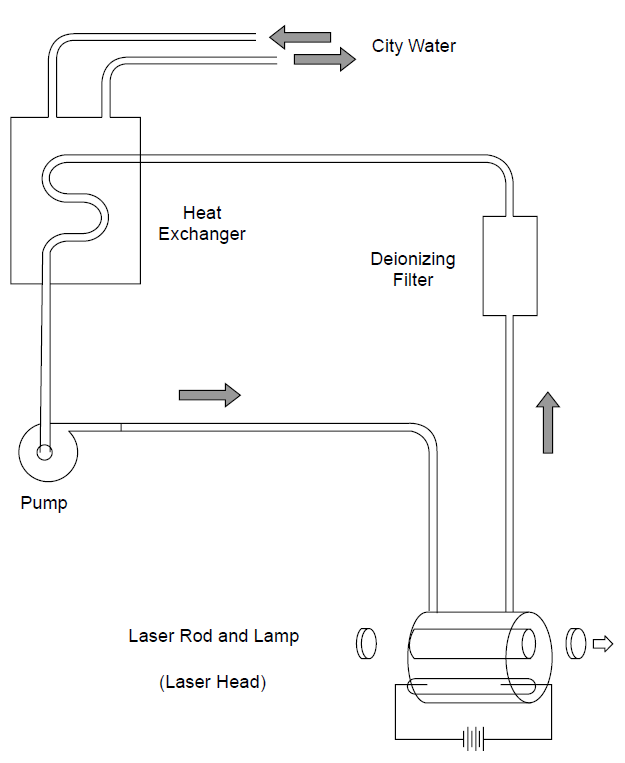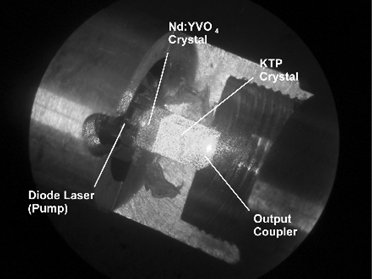


 الفيزياء الكلاسيكية
الفيزياء الكلاسيكية
 الكهربائية والمغناطيسية
الكهربائية والمغناطيسية
 علم البصريات
علم البصريات
 الفيزياء الحديثة
الفيزياء الحديثة
 النظرية النسبية
النظرية النسبية
 الفيزياء النووية
الفيزياء النووية
 فيزياء الحالة الصلبة
فيزياء الحالة الصلبة
 الليزر
الليزر
 علم الفلك
علم الفلك
 المجموعة الشمسية
المجموعة الشمسية
 الطاقة البديلة
الطاقة البديلة
 الفيزياء والعلوم الأخرى
الفيزياء والعلوم الأخرى
 مواضيع عامة في الفيزياء
مواضيع عامة في الفيزياء|
Read More
Date: 9-3-2016
Date: 1-12-2016
Date: 11-4-2016
|
LASER STRUCTURE (YAG Lasers)
Lamp pumping (occasionally, flash lamps, but in many cases CW arc lamps) is used by the largest YAG lasers, most of which use YAG instead of a different host since YAG has better thermal properties. With few absorption peaks in the visible regions of the spectrum, YAG is not well suited for pumping with xenon lamps, which emit primarily in the violet to green region, although for many flash lamp-pumped YAG lasers, xenon lamps are used, due primarily to their lower cost. Krypton, with an output rich in the red region, is a better match and is used extensively for CW arc lamps used to pump YAG lasers.
CW arc lamps operate at low voltages and high currents. In most YAG lasers a linear lamp is employed in which pump light from the lamp is coupled to the YAG rod via an elliptical reflector. By placing the YAG rod and the lamp each at a focus of the ellipse pump, light is effectively coupled to the rod. Reflectors are frequently machined from a block of stainless steel coated with pure gold since gold reflects red and IR wavelengths (i.e., wavelengths at which YAG absorbs) quite well. Gold is also resistant to corrosion, important since the reflector is usually bathed continuously in cooling water. Larger lasers such as the one shown in Figure 1.1 may use two or more lamps. This particular high-power YAG laser (used for welding) uses a ceramic reflector that can take thermal shock well.
CW arc lamps (and even many flash lamps) must be water cooled to remove the kilowatts of heat produced by the lamps. The entire lamp and rod are usually immersed in flowing deionized water since it is an insulator and will not short the electrical terminals of the lamp (nor corrode the metal reflector). Such lasers usually have a closed water-cooling loop in which deionized water is recirculated through the laser housing and heat is exchanged with a supply of city water. The water cooling system for a typical YAG laser is shown in Figure 1.2.
Large lasers such as these feature separate optics, with the laser head and optics all mounted on a rail, allowing adjustment. Tubing for cooling water as well as wires to power the lamp are usually run between the separate power supply and the laser itself. Use of an optical rail also allows the addition of intracavity components such as Q-switches and harmonic generators as required.
While lamp pumping is used for the highest-powered YAG lasers, the highest efficiencies are achieved when these materials are pumped using a semiconductor laser. Output powers are lower than possible with lamp pumping, with most diode-pumped solid-state (DPSS) lasers limited to under 5 W. Whereas both YAG and vanadate exhibit a large absorption peak at 808 nm, precisely where semiconductor lasers can emit, many DPSS lasers use vanadate since it has a much lower pumping threshold than YAG. Mere milli watts of pump power are sufficient to pump

Figure 1.1. YAG rod and pump lamps.

Figure 1.2. Water cooling for a YAG laser.
such a laser to threshold (important when the pump laser is limited to milli watts), so this is the material of choice for compact solid-state lasers. Like ruby, it is a self-polarizing material, making design of compact SHG DPSS lasers much easier than with YAG, which is randomly polarized.
On the small end of the scale are green laser pointers. These compact units usually consist of a diode-pumped vanadate crystal coupled with a KTP SHG crystal. Dielectric mirrors are deposited directly onto the crystal faces, the rear (HR) coating allowing 808 nm pump light from a semiconductor laser to pass through to excite the vanadate. The entire assembly (vanadate, KTP, HR, and OC) is prealigned as a single package, the only external component being the pump laser with associated power supply. Figure 1.3 details the components of a small DPSS laser used in a green laser pointer.
Upon exit from the laser, the beam passes through a collimation lens as well as a filter, which removes any 808-nm pump light or 1064-nm IR light remaining. Powers of up to 5 mW are common from such laser pointers, with larger versions

Figure 1.3. DPSS laser components.
(used primarily in the laboratory as a general-purpose laser) available which use the same basic configuration (i.e., a single-crystal assembly) boasting powers of up to 100 mW. Larger DPSS lasers tend to use separate components and optics, which also allows the inclusion of intracavity devices such as Q-switches.



|
|
|
|
لصحة القلب والأمعاء.. 8 أطعمة لا غنى عنها
|
|
|
|
|
|
|
حل سحري لخلايا البيروفسكايت الشمسية.. يرفع كفاءتها إلى 26%
|
|
|
|
|
|
|
جامعة الكفيل: شراكتنا مع المؤسّسات الرائدة تفتح آفاقًا جديدة للارتقاء بجودة التعليم الطبّي في العراق
|
|
|